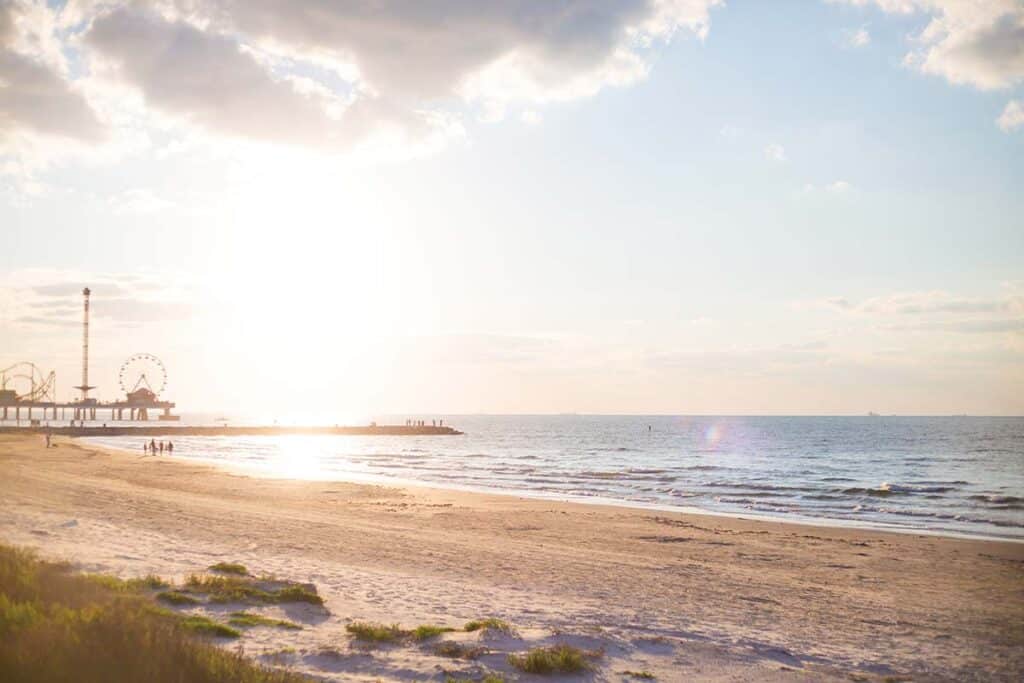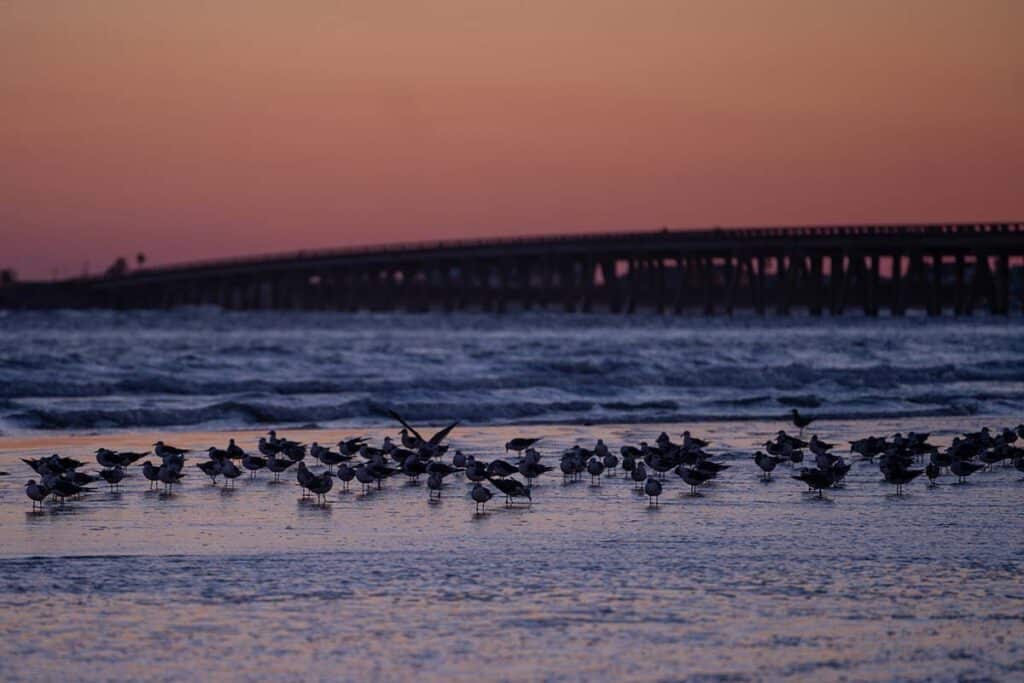Before packing your bags and heading over to the beach to relax, it’s not uncommon to search for popular destinations and those with clear water and clean (or white) sand. Galveston Beach is one of the most highly rated public beaches in Texas. Still find some reviews with three similar words: “Galveston beach dirty,” but experts have an explanation for this.
So why is Galveston Beach dirty? Its murky, brownish water is due to the sediments coming from other bodies of water, its shallow shoreline, and the presence of fine sand. At times, there’s an increase in the bacterial count that changes the water’s natural state and trash some visitors leave behind.
Gain a more in-depth understanding of these specific reasons through this post. More than that, we will help you decide whether it’s safe to swim in Galveston Beach water or when it’s safest to visit and take a plunge.
Why Is Galveston Beach Water Dirty or Appear Dirty?

Here’s a detailed explanation of the natural and human-made causes of why Galveston Beach is dirty or appears cloudy and dirty:
Sediments Running Off Into the Beach Water
Blame it on its location; Galveston Beach receives most of the sediments from the Mississippi, Trinity, Yazoo, and Atchafalaya rivers that usually drain into the Gulf. These high-speed, high-volume bodies of water continuously churn out the swamp land sediments or sand.
While doing so, the Texas coastline gets caught up in the process. A huge portion of these sediments run off toward it as they get pushed by the Gulf of Mexico’s currents. That is especially since the ocean’s water moves from the west to the east due to the Earth’s rotation.
Very Fine Sand Size
Galveston Beach also has many sandbars or horizontally raised mounds of fine (almost silt-like) sand that you can walk on to reach the deeper waters. Its very fine size means it can easily be disturbed or agitated and stay floating for extended periods.
It also makes it easy for the waves to mix with the beach water, leading to brownish-colored water. Likewise, it will take longer for the tiny sand particles to settle at the beach’s bottom, leading to the water carrying them wherever it goes.
The stronger the waves or winds, the darker Galveston Beach’s water becomes. It’s also why the water becomes a bit green or blue rather than brown when the waves are calmer.
Shallow Shoreline
Galveston Beach’s shallow shoreline brings the sediments up, making them more visible. Hence, the water has a very visible brown color.
Beaches with shallow shorelines or water also have high sand and sediment turnover. That’s because they don’t have enough ocean floor flora that could otherwise contribute to trapping sediments, which, in turn, clear the beach water.
Increased Bacterial Count
Like our human body, bodies of water and sand have non-harmful microbes, including bacteria. However, it changes the water’s condition when the number increases.
So, while asking “What makes Galveston Beach dirty?” is more appropriate for the first three causes than “Why is Galveston beach water dirty?“, the higher bacterial level actually makes the water dirty.
That said, this change in this concentration only happens after significant or heavy rainfall. Why is this so, you may ask?
When the rain increases the water amount, it flows not just with the usual sediments. It can also carry waste and microorganisms because it runs through other landforms. These lands may have livestock, pet waste, and other elements that can contaminate the grounds.
It acts as a septic system during these times, which is common in some bodies of water, especially recreational beaches.
Also, when a particular area faces sewer system issues, the beach water can be contaminated with bacteria found in human feces. Nonetheless, the government ensures these problems get fixed as soon as possible.
So if you’re wondering and asking, “How dirty is Galveston Beach during and a few days after these events?” the answer would be too dirty at a microscopic level. Expect that the water is murkier than usual and is often discolored during these times.
Trash Left by Humans
This is likely the most obvious answer to “Why is Galveston Beach dirty?” Whether we like it or not, some people nowadays leave behind beverage containers, food wrappers, and other items no matter where they go. Worst? They do so even if littering isn’t allowed.
This problem is most common during the peak season, as the area is more crowded than usual. After all, Galveston is a public beach.
Is It Safe to Swim at Galveston Beach?

Sanitation is one of the top concerns when we see murky water. With Galveston Beach having such characteristics for many reasons, it’s critical to know whether it’s safe to swim in its water and sunbathe on its sand, even if you’ll rest on your sand-proof beach towel (View on Amazon). As such, here’s detailed information about how safe it is to swim at Galveston Beach and safety considerations to keep in mind:
Safe in Most Seasons
With sediments being the main answer to “Why is Galveston Beach dirty?” generally, it’s safe to swim and enjoy other recreational activities in the area. In fact, Texas A&M University in Oceanography’s research assistant professor, Kristen Thyng, once stated: “The brownish water is not anything bad or unhealthy.“
Additionally, the Galveston Bay Foundation performs a monthly water quality test to ensure it isn’t polluted and unsafe for humans and other living things.
Unsafe During or After a Heavy Rainfall
Apparently, swimming during the rainy season isn’t safe because the water current is usually stronger or unpredictable. It increases your risk of drowning.
A few weeks after heavy rainfalls won’t also be the safest because, as mentioned, it’s when the water contains the highest level of bacteria. Likewise, it can be filled with harmful bacteria, depending on where the water ran off, before draining or running into Galveston Beach. These bacterial species usually cause gastrointestinal diseases, while some cause flesh-eating diseases.
With those in mind, one of the visible signs of high bacterial concentration is an increased number of algae floating in the beach water. You may also find dead fish floating or dead wildlife around the area.
Fortunately, like most beaches in the US, Galveston Beach gets regularly checked for bacterial contamination. Plus, the beach will be temporarily closed and tested daily (until it clears up) when there’s a significant level of harmful microorganisms.
Color Codes
That said, it’s always best to check beach advisories before planning your Galveston Beach vacation. You can call the beach or visit their official website. Alternatively, you can visit the Texas Beach Watch website that uses color codes for their advisories, namely:
- Green: Safe (Up to 35 CFUs (Colony Forming Units) of bacteria per 100ml of beach or saltwater)
- Yellow: Elevated bacterial count (Above 35 CFUs of bacteria per 100ml of beach or saltwater)
- Red: Beach closed (Up to 104 CFUs of bacteria per 100ml of beach or saltwater)
Checking the current Galveston Bay Foundation beach water quality report or Swim Guide’s latest bacterial concentration report is also advisable. Doing any of these ensures you don’t risk your health or won’t be wasting your time, effort, and money.
Also, refrain from swimming when you have open wounds, even on days when it’s safe to swim. That’s because your wound can get infected by any form of bacteria.
Similarly, be careful not to accidentally drink the beach water and touch your mouth after swimming and touching the sand unless you have already washed your hands before doing so
Might Be Unsafe During the Peak Season
The trash littered by visitors isn’t just an eyesore but can also lead to unsanitary conditions that can harm humans and animals. Yes, mostly, it’s left on the sand, which you can accidentally step and trip on. Still, the trash can be washed away into the water.
Who would want to lounge and swim with wrappers, bottles, and other similar items, right? That’s why it’s advisable to check which area of the beach is less populated during the peak season. As mentioned, there’s a higher chance that the beach has trash when there are many people.
What About Sharks?
Besides knowing the answer to “How dirty is Galveston Beach?”, determining whether or not a shark is roaming around the area is essential to ensure your safety while swimming.
Well, every ocean has sharks, and Galveston Beach isn’t different. Nonetheless, as long as you don’t harm them, they won’t hurt you. It’s also best to avoid swimming during dusk and dawn since these are their feeding times. One sign they’re around is fish jumping, so get out of the water immediately to avoid being mistaken for shark bait.
Additionally, there are four species of sharks commonly found in Galveston Beach, and each of them has specific behaviors you need to know about:
- Bonnethead: Gives birth near the shore and loves warm water, so they’re usually around during summertime.
- Bull: Always around when the climate is warm
- Sharpnose: Near the shores from May to July, their mating seasons
- Spinner: Near the shoreline during the summer season
If You See One
If you spot a shark in the water, experts recommend staying as calm as possible, even when it’s hard to do so. Also, always maintain eye contact or face the shark; never turn your back.
Remember, sharks are predators or hunters, so them knowing that you see them will most likely prevent them from attacking you.
Then, slowly make your way to the shore since sudden, rapid movements can cause the shark to feel that it’s in danger or think you’re food.
Although hurting a shark isn’t advisable, you might be caught up in a situation when a seemingly aggressive shark approaches you. What you need to do is to punch or hit any of its most sensitive body parts: gills or eyes. Doing so will give you time to swim away from it or to the shore.
Additionally, keep in mind that anything that flashes, especially in murky water, like Galveston Beach’s, the shark might think it’s fish or food. Thus, refrain from wearing any jewelry when swimming. It’s also best to wear non-glossy swimwear in basic colors (view on Amazon).
Go Ahead and Book That Galveston Beach Vacation!

Galveston Beach truly has water with color and opacity that most people equate to “dirty, contaminated, polluted, and unsafe.” However, it isn’t the case since both are mainly due to sediments or purely sand.
Of course, there are instances when it isn’t safe to swim in Galveston Beach or any beach, for that matter. Nonetheless, you don’t have to worry because the State of Texas and other private institutions closely monitor the beaches. They also give early warnings and advisories and take the necessary steps to keep the beach as safe as possible for all visitors.
So, if you’re ready to enjoy Galveston Beach and there are no safety and closure advisories, pack your swimming essentials and waterproof action camera (view on Amazon) to have a fun and memorable vacation!
